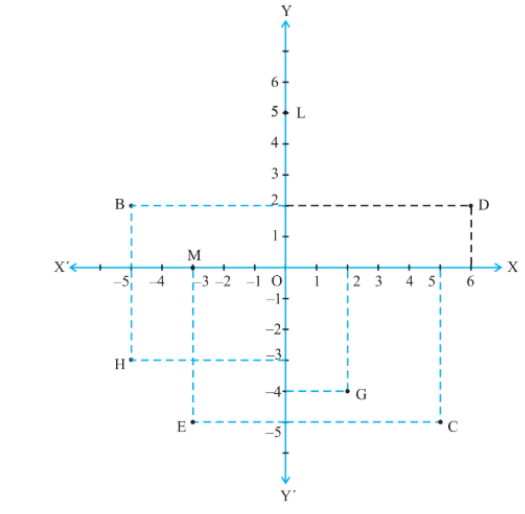ಚಿತ್ರ 9.14 ನ್ನು ನೋಡಿ, ಕೆಳಗಿನವುಗಳನ್ನು ಬರೆಯಿರಿ. (i) B ಯ ನಿರ್ದೇಶಾಂಕಗಳು (ii) C ಯ ನಿರ್ದೇಶಾಂಕಗಳು (iii) (-3, -5) ನಿರ್ದೇಶಾಂಕಗಳಿಂದ ಗುರುತಿಸುವ ಬಿಂದು. (iv) (2, -4) ನಿರ್ದೇಶಾಂಕಗಳಿಂದ ಗುರುತಿಸುವ ಬಿಂದು. (v) D ಬಿಂದುವಿನ ಕ್ಷಿತಿಜಸೂಚಕ (vi) H ಬಿಂದುವಿನ ಲಂಬಸೂಚಕ (vii) L ಬಿಂದುವಿನ ನಿರ್ದೇಶಾಂಕಗಳು (vii) M ಬಿಂದುವಿನ ನಿರ್ದೇಶಾಂಕಗಳು
Step by step video & image solution for ಚಿತ್ರ 9.14 ನ್ನು ನೋಡಿ, ಕೆಳಗಿನವುಗಳನ್ನು ಬರೆಯಿರಿ. (i) B ಯ ನಿರ್ದೇಶಾಂಕಗಳು (ii) C ಯ ನಿರ್ದೇಶಾಂಕಗಳು (iii) (-3, -5) ನಿರ್ದೇಶಾಂಕಗಳಿಂದ ಗುರುತಿಸುವ ಬಿಂದು. (iv) (2, -4) ನಿರ್ದೇಶಾಂಕಗಳಿಂದ ಗುರುತಿಸುವ ಬಿಂದು. (v) D ಬಿಂದುವಿನ ಕ್ಷಿತಿಜಸೂಚಕ (vi) H ಬಿಂದುವಿನ ಲಂಬಸೂಚಕ (vii) L ಬಿಂದುವಿನ ನಿರ್ದೇಶಾಂಕಗಳು (vii) M ಬಿಂದುವಿನ ನಿರ್ದೇಶಾಂಕಗಳು by Maths experts to help you in doubts & scoring excellent marks in Class 9 exams.
Updated on:21/07/2023Similar Questions
वह चतुर्थांश ज्ञात कीजिए जिसमे निम्न बिंदु स्थित है -
(i)(2,5) (ii)(−3,2) (iii)(−2,−5) (iv)(2,−3)
(v)(4,−4) (vi)(−3,−9) (vii)(3,3) (viii)(−8,4)
View Solutionनिम्नलिखित को अदिश और सदिश में वर्गीकरण कीजिये|
(i) 5 सेकंड, (ii) 10 kg , (iii) 40∘, (iv) 40 वाट , (v) 20m/sec2 , (vi) 2 मी उत्तर-पशिच्म , (vii) 10−19 कूलंब
View Solutionनिम्नलिखित आयनों के इलेक्ट्रॉनिक अभिविन्यास लिखिए-
(i) H−,(ii)Li+,(iii)F−,(iv)S2−,(v)Al3+,(vi)Cl3+,(vii)Mn2+,(viii)Fe2+ और Fe3+
View SolutionOn a graph paper, plot each of the following points:
(i) A(4, 3)
(ii) B(-2, 5)
(iii) C(0, 4)
(iv) D(7, 0)
(v) E(-3, -5)
(vi) F(5, -3)
(vii) G(-5, -5)
(viii) H(0, 0)
View SolutionSee fig and Write the following :
(i) The coordinates of B
(ii) The coordinates of C
(iii) The point identified by the coordinates (-3,-5)
(iv) The point identified by the coordinates (2,-4)
(v) The abscissa of the point D .
(vi) The ordinates of the point H .
(vii) The co-ordinates of the point L .
(viii) The co-ordinates of the point M .

View SolutionWrite down the electronic configuration of :
(i) Cr3+
(ii) Cu+
(iii) Co2+
(iv) Mn2+
(v) Pm3+
(vi) Ce4+
(vii) Lu2+
(viii) Th4+
View SolutionSee Fig.3.14. and write the following:(i) The coordinates of B.(ii) The coordinates of C.(iii) The point identified by the coordinates (−3, −5).(iv) The point identified by the coordinates (2, −4). (v) The abscissa of the point D. (vi) The ordinate of the points H. (vii) The coordinates of the points L. (viii) The coordinates of the point M.

View Solution
